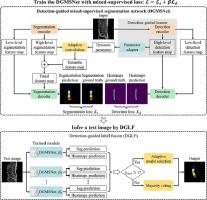Medical Image Analysis ( IF 10.7 ) Pub Date : 2021-10-27 , DOI: 10.1016/j.media.2021.102261 Shumao Pang 1 , Chunlan Pang 2 , Zhihai Su 3 , Liyan Lin 1 , Lei Zhao 1 , Yangfan Chen 1 , Yujia Zhou 1 , Hai Lu 3 , Qianjin Feng 1

|
Spine segmentation for magnetic resonance (MR) images is important for various spinal diseases diagnosis and treatment, yet is still a challenge due to the inter-class similarity, i.e., shape and appearance similarities appear in neighboring spinal structures. To reduce inter-class similarity, existing approaches focus on enhancing the semantic information of spinal structures in the supervised segmentation network, whose generalization is limited by the size of pixel-level annotated dataset. In this paper, we propose a novel detection-guided mixed-supervised segmentation network (DGMSNet) to achieve automated spine segmentation. DGMSNet consists of a segmentation path for generating the spine segmentation prediction and a detection path (i.e., regression network) for producing heatmaps prediction of keypoints. A detection-guided learner in the detection path is introduced to generate a dynamic parameter, which is employed to produce a semantic feature map for segmentation path by adaptive convolution. A mixed-supervised loss comprised of a weighted combination of segmentation loss and detection loss is utilized to train DGMSNet with a pixel-level annotated dataset and a keypoints-detection annotated dataset. During training, a series of models are trained with various loss weights. In inference, a detection-guided label fusion approach is proposed to integrate the segmentation predictions generated by those trained models according to the consistency of predictions from the segmentation path and detection path. Experiments on T2-weighted MR images show that DGMSNet achieves the state-of-the-art performance with mean Dice similarity coefficients of and for segmentations of 5 vertebral bodies and 5 intervertebral discs on the in-house and public datasets respectively.
中文翻译:

DGMSNet:通过检测引导的混合监督分割网络对 MR 图像进行脊柱分割
磁共振(MR)图像的脊柱分割对于各种脊柱疾病的诊断和治疗很重要,但由于类间相似性,即相邻脊柱结构中出现形状和外观相似性,仍然是一个挑战。为了减少类间相似性,现有方法侧重于增强监督分割网络中脊柱结构的语义信息,其泛化受限于像素级注释数据集的大小。在本文中,我们提出了一种新颖的检测引导的混合监督分割网络(DGMSNet)来实现自动脊柱分割。DGMSNet 由用于生成脊柱分割预测的分割路径和用于生成关键点的热图预测的检测路径(即回归网络)组成。在检测路径中引入检测引导学习器生成动态参数,该参数用于通过自适应卷积生成分割路径的语义特征图。由分割损失和检测损失的加权组合组成的混合监督损失用于训练具有像素级注释数据集和关键点检测注释数据集的 DGMSNet。在训练过程中,一系列模型被训练了不同的损失权重。在推理方面,提出了一种检测引导的标签融合方法,根据分割路径和检测路径的预测一致性,整合那些训练好的模型生成的分割预测。对 T2 加权 MR 图像的实验表明,DGMSNet 实现了最先进的性能,平均 Dice 相似系数为和分别在内部和公共数据集上分割 5 个椎体和 5 个椎间盘。











































 京公网安备 11010802027423号
京公网安备 11010802027423号